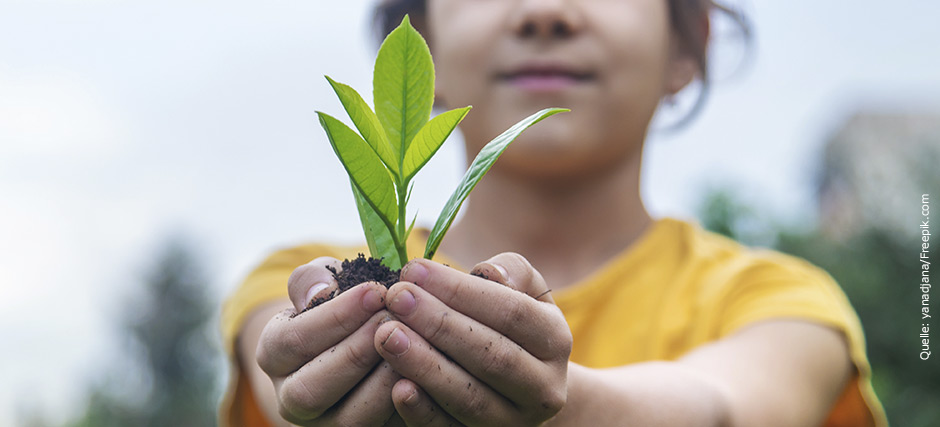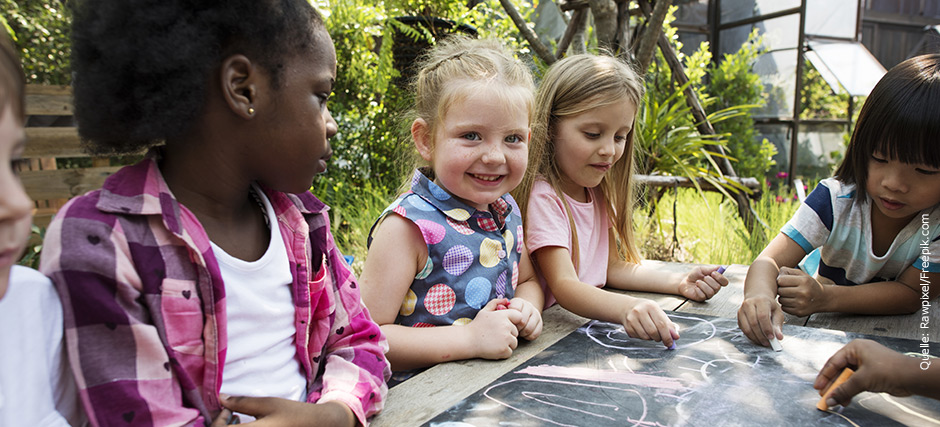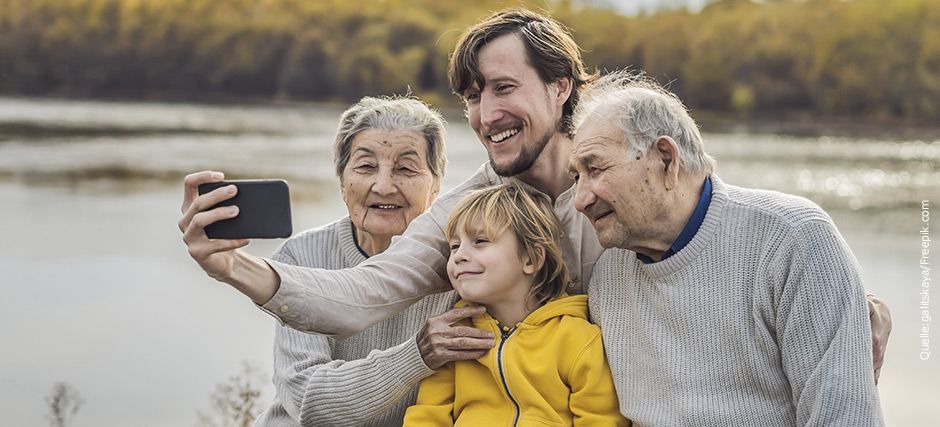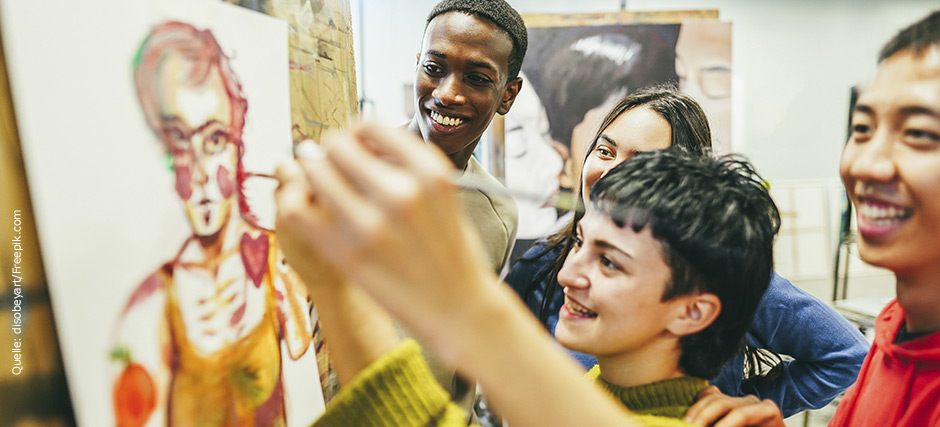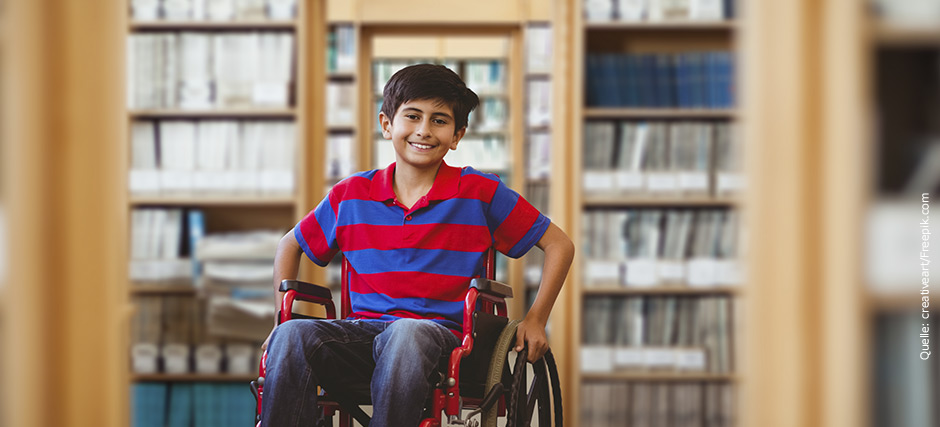How dare you?[1]
The responsibility of child and youth welfare for the implementation of children’s environmental rights
Discussion paper by the Child and Youth Welfare Association – AGJ*/ German National Committee for Early Childhood Education (DNK)
Abstract
The climate crisis is one of today’s dominating topics, and compels many people to take to the streets. They are demanding that politics and society do their bit for the preservation of the Earth and its ecosystems, and that they take the measures necessary to do so. The impacts of the climate crisis affect all people, in particular people in the Global South as well as children and young people all over the world. With this paper, the Child and Youth Welfare Association – AGJ is bringing awareness to the relevance of children’s environmental rights and demanding the effective implementation thereof. The AGJ refers to the UN Convention on the Rights of the Child, and determines that intact environmental conditions are the foundation for the realisation of almost all children’s rights. Beyond this, the connection to the Sustainable Development Goals and the consequent goal of education for sustainable development are explained and carried over to the processes in child and youth welfare. From this, the AGJ derives the following recommendations: Children and young people need places where they can work on “their” issues; child and youth welfare must support and defend these places. This also includes strengthening the motivation and self-efficacy of children and young people so that they can stand up for these issues. However, child and youth welfare itself must serve as an example for sustainable development in its actions – this must be reflected in framework conditions, concepts and so on. As a final point, the AGJ deems it important that child and youth welfare advocates (more) for sustainable development, actively approaching relevant players and structures in this field and continuing to work towards strengthening and implementing the UN Convention on the Rights of the Child.
Introduction
The climate crisis, environmental damage and the collapse of entire ecosystems are some of the most pressing challenges of our time. They affect every single person on the globe, but some more than others: children and young people across the world, and people who live in the Global South. The people who are least responsible for the climate crisis are the most heavily affected by its repercussions. Due to their lower economic power, the states in which they live are often barely able to raise the resources to achieve any kind of change.
Children and young people worldwide are particularly exposed to the climate crisis and the destruction of the environment. Floods or extreme weather are increasingly leading to children, young people and their families being forced to leave their familiar surroundings. According to the WHO[2], in the year 2016 alone, 600,000 children worldwide died due to toxic substances in the air. And children are also hit especially hard by indirect consequences of the climate change, such as food insecurity and the spread of pathogens.
It is not only in global terms that burdens as a consequence of environmental problems are unevenly distributed. With regard to health, the German Environment Agency has determined that this is also the case for Germany. The German Environment Agency concludes from social and environmental epidemiological studies from recent years that social status decides whether and to what extent children, young people and adults are negatively affected by environmental pollutants. The findings show that socio-economic factors, such as income and education, as well as further factors, e.g. migration background, the social environment, lifestyles and living conditions have an impact on the available resources as well as associated health risks of the people. The studies show a tendency for people with a low social status to be more heavily burdened by negative environmental influences. For example, they are more frequently subjected to traffic-related health risks such as noise and pollutants, and their access to urban green spaces is limited. As a result, they have fewer opportunities for movement, recreation and therefore also for development.[3]
Children and young people throughout the world are standing up for a sustainable climate policy. The protection of the environment and the climate are now among the most important issues for young people. They are loud and unrelenting players who are driving forward the discussions on environmental topics in the general public. By doing so, they have created pressure for politicians to take action. Many young people in Germany have themselves already got actively involved to promote the preservation of the climate, the considerate treatment of the environment and the conservation of our natural habitat.[4] This means that the protection of the environment and climate have also become matters in which children and young people stand up for their rights, noticeably and with particular assertiveness. The reference to intergenerational justice and the feeling of having to pay for the errors of the older generation when it comes to climate protection play a major role here.[5] At the same time, the children and young people are, at least partially, aware of their own responsibility. Children and young people in Germany are not just aggrieved parties when considering the destruction of the environment ushered in by the previous generations. They are also beneficiaries of the economic prosperity and the growth experienced so far, of the technological upgrading of the western industrialised nations. As protagonists in the fight against the destruction of the environment, they are called upon to reconsider the consumer behaviour, ways of thinking and values of their own generation, as they themselves are a part of the system that is causing the excessive emissions of CO2, the global climate change and thus the distress of children in other parts of the world. Nonetheless, they must occasionally rely on adults to understand the backgrounds of these issues and above all to overcome ecological challenges. It is mainly adults who communicate and shape policies and education, and thereby decide what opportunities for democratic participation children receive. In the best case, adults can become role models and relevant partners for greater climate and environmental protection.
With this paper, the Child and Youth Welfare Association – AGJ aims to bring awareness to the relevance of children’s environmental rights and demands the effective implementation thereof worldwide. In addition, it clarifies that intact environmental conditions are the foundation for the realisation of almost all children’s rights. In this context, the associated role and tasks of child and youth welfare are described and used to derive recommendations.
What are children’s environmental rights?
Children’s environmental rights are child rights that are connected to the environment and development conditions. On 23 September 2019, children and young people from all over the world demonstrated how this connection can be established when they submitted an individual complaint at the UN Committee on the Rights of the Child. With this complaint, children and young people stated that the United Nations were not undertaking enough against the climate crisis and that this violated the UN Convention on the Rights of the Child (UNCRC) and thus the rights of children and young people. They referred, among other things, to their right to life as set out in Art. 6 and their right to health as set out in Art. 24 of the UN Convention on the Rights of the Child. Amongst the accused is also the Federal Republic of Germany, which is one of the world’s largest emitters of greenhouse gases.[6]
Against the backdrop of the climate crisis and the pronounced effects on children and young people, some organisations are demanding a separate child’s right to a healthy environment. This demand aims to highlight the significance of the ecological dimension of existing rights.[7]
Child rights related to the environment
- Article 3 [best interests of the child]
(2) States Parties undertake to ensure the child such protection and care as is necessary for his or her well-being, taking into account the rights and duties of his or her parents, legal guardians, or other individuals legally responsible for him or her, and, to this end, shall take all appropriate legislative and administrative measures. - Article 6 [right to life]
(2) States Parties shall ensure to the maximum extent possible the survival and development of the child. - Article 19 [protection from violence, abuse and neglect]
(1) States Parties shall take all appropriate legislative, administrative, social and educational measures to protect the child from all forms of physical or mental violence, injury or abuse, neglect or negligent treatment, maltreatment or exploitation, including sexual abuse, while in the care of parent(s), legal guardian(s) or any other person who has the care of the child. - Article 24 [health and health services]
(2c) States Parties shall pursue full implementation of this right (the right to health) and, in particular, shall take appropriate measures to combat disease and malnutrition, including within the framework of primary health care, through, inter alia, [...] the provision of adequate nutritious foods and clean drinking-water, taking into consideration the dangers and risks of environmental pollution.
Many of the rights included in the UNCRC have a connection to the environment and to the healthy development of children and young people. Accordingly, environmental child rights can be derived from the Convention on the Rights of the Child. Therefore, as long as there is no explicit foundation for children’s environmental rights under international law or national legislation, reference may be made to the UNCRC. For the articles of the UNCRC depicted in the box, the connection to the environment and the climate is established, but many other children’s rights also have a connection to the environment. The Convention on the Rights of the Child is divided into protection rights, provision rights and participation rights, and follows four guiding principles:
- Right to equality and protection from discrimination: the right to equal treatment of all children (article 2).
- Primary consideration of the best interests of the child: the right to consider the best interests of the child in all actions concerning children (article 3).
- Ensuring survival and development: the right to the best possible chances of survival and development (article 6).
- Respecting the views of the child: the right to the free expression of views and for these views to be respected (article 12).
For the realisation of almost all children’s rights, intact environmental conditions are both fundamental and essential. The United Nations Committee on the Rights of the Child has already made this clear in its comments, emphasising this especially in the rights to survival and development (article 6 of the Convention on the Rights of the Child) as well as food and adequate housing (article 27).[8] It follows that it is the duty of the states that have pledged to observe the UNCRC to contribute to the implementation of children’s environmental rights and to put these into practice. As the framework condition for the obligation to protect children and young people, an obligation to protect the environment also arises.
A further important point of reference for children’s environmental rights are the Sustainable Development Goals (SDGs) enshrined by the United Nations (UN) in 2015. These were created with the aim of promoting guaranteed sustainable development at an economic, social and ecological level. The 17 goals comprise many dimensions of sustainability and apply to all countries. In Germany, they are incorporated, amongst other things, as a framework for action in the German sustainability strategy as well as in programmes of numerous ministries. One fundamental aspect for the implementation of the United Nations’ agenda by the year 2030 is education for sustainable development (ESD), which is mentioned in the fourth goal of the SDGs. There, it states:
- “By 2030, [it must be] ensure[d] that all learners acquire the knowledge and skills needed to promote sustainable development, including, among others, through education for sustainable development and sustainable lifestyles, human rights, gender equality, promotion of a culture of peace and non-violence, global citizenship and appreciation of cultural diversity and of culture’s contribution to sustainable development.”[9]
Here, ESD builds upon two different levels, the level of knowledge and the level of ability and competences. On the one hand, basic knowledge for dealing with key societal problems is imparted. On the other, ESD is designed to enable learners to recognise challenges and find their own approaches and solutions, i.e. to develop so-called “Gestaltungskompetenz (shaping competence)”[10], or the competency to shape the future. Beyond the constraints of specific contents, ESD aims to convey to people the competence to shape their own environment themselves. With this in mind, good education goes beyond pure factual knowledge and enables all people to develop skills such as
- forward-looking thinking;
- interdisciplinary knowledge;
- autonomous and cooperative action;
- dealing with complexity;
- participation in societal decision-making processes.
This involves questioning values and developing one’s own commitment. This type of education policy transformation, which is not limited to formal learning settings, requires strong and effective institutions, close cooperation and new patterns of behaviour. ESD is based on an extended understanding of education as “holistic and transformational education which addresses learning content and outcomes, pedagogy and the learning environment”[11] while simultaneously corresponding to concepts of justice. By now, ESD is firmly anchored in all educational fields in Germany, is backed by an extensive monitoring process and is accompanied across education sectors as part of the National Platform on ESD.[12] However, no unified understanding of ESD has yet emerged in the educational plans and curricula of the 16 federal states, neither regarding the contents nor in terms of a methodical realisation and structural implementation. A National Action Plan for the implementation of the UNESCO Global Action Programme on Education for Sustainable Development (2015-2019) was adopted in 2017. Its objectives and recommendations for action are intended to lead to the implementation of ESD in the German education landscape.[13]
Even though there is no explicit agreement for the implementation of children’s environmental rights to date, the Convention on the Rights of the Child provides a good foundation for the consideration and strengthening of children’s rights in the context of the environment, given that it contains both protection as well as participation rights. The SDGs put the mission for sustainable development into concrete terms, and education for sustainable development is one of the most important missions for all educational institutions worldwide.
Child and youth welfare is required to ask itself the question of how a sustainable transformation can be implemented in recommendations for action, guidelines, concepts and discourses within child and youth welfare. After all: Sustainable development is not just related to environmental issues, but is instead a holistic approach that is aimed at strengthening the representation and self-efficacy of youth as a whole, whereby the AGJ will concentrate on children’s environmental rights further in this paper.
What is the mission and role of child and youth welfare in the context of children’s environmental rights?
The mission of child and youth welfare to support young people, to get them involved and to maintain or create a child-friendly and family-friendly environment is consistent with children’s environmental rights. At the same time, in accordance with the outlined understanding, the implementation of children’s environmental rights goes far beyond the implementation of specific measures for the protection of the environment. In light of this mission, the actors involved in child and youth welfare play a pivotal role in the implementation of children’s environmental rights.
In the context of children’s environmental rights, child and youth welfare has the statutory duty to create spaces for children and young people in which they are able to gain their own experiences, experience self-efficacy, discover and formulate interests and stand up together for what they believe in. When doing so, they must be accompanied and supported by the actors involved in child and youth welfare, and must perceive them as points of contact.[14] The participation opportunities for children and young people created by child and youth welfare reinforce their confidence and encourage them to also get involved in politics and other contexts. Child and youth welfare can thus create a basis for the commitment of young people, in addition to addressing children’s environmental rights and related topics in the offers provided by the welfare itself. The mission of child and youth welfare, from work with youth associations to assistance with upbringing, is to motivate young people to accept joint social responsibility and show social commitment, as well as to empower their capacity for self-determination.
Indirectly or directly, the youth associations and youth councils in particular have been and are consistently involved in social protests by participating in and helping to organise these events as associations, and by providing spaces and other resources for the exchange of ideas and other activities. Furthermore, social, natural history and political education are cornerstones of the offers provided by youth work, and therefore have an influence on the commitment of young people. Here, the mission of youth work and youth associations necessarily entails addressing the needs and interests of young people, and doing justice to these when designing their offers. By implication, this also means devoting (more) energy to issues surrounding children’s environmental rights.
The promotion of commitment and participation begins as early as at day care. This is where children learn to articulate their needs, to tackle topics within a group and to get involved in everyday life. In this process, environmental and democracy education should go hand in hand with nature education approaches. After all, for one thing, the health-promoting effects of experiences of nature as well as beneficial effects on physical, mental and social health are proven. For another, nature experiences in childhood are an important factor for the commitment to the environment and the conservation of nature later in life. Elementary nature experiences create a connection to ecological factors and make it easier to develop a feeling of responsibility for people and the environment.[15]
In these spheres of action of child and youth welfare, an appropriate attitude is required of the actors so that children and young people can experience nature and the environment as worthy of conserving, and also experience true participation and self-efficacy.[16] What this means is that qualified employees and volunteers in child and youth welfare must see the relevance and topicality of the climate crisis and the destruction of the environment, confront the potential consequences (including globally), accompany children and young people in their worries and fears, and address the issue of sustainability in all its dimensions.
Furthermore, a major role of child and youth welfare consists of supporting children and young people in a legal capacity. The close examination of environmental and climate issues should aim to not only provide competent information, but also to draw consequences for the individual actions of each and every human being. Advocacy also means protecting children and young people who are criticised by adults or who are subject to hate speech as a result of their commitment. It also means providing emotional support and encouragement and taking firm action in support of the target group.
The actors involved in child and youth welfare must therefore more intensively consider how they can support their target audience in standing up for their own interests. At the same time, child and youth welfare itself is called upon to advocate for and represent young people when it comes to environmental topics. This also involves intervening in an interdepartmental fashion in plans and measures, e.g. construction projects, urban development plans, climate concepts and traffic concepts, and bringing in the perspective of children and young people: It would make sense, for example, if in transport committees, alongside children and young people themselves, representatives of child and youth welfare were also present and could indicate in the planning of new projects where children and young people are affected by more noise and traffic, and where designated playing streets are needed because a lot of children live in the area. Many municipal codes and local constitutional laws intend for the participation of young people and their associations in the decisions that affect them; unfortunately, this participation is not sufficiently put into practice. Child and youth welfare lives up to its advocacy role when it campaigns for the access of children and young people to participation in political decisions and represents them where they have no access. Supporting children and young people in being heard in their immediate environment, in their school, in their municipality and also at a national level are examples of putting this advocacy into practice.
Despite their major socio-political relevance and apparent points of reference with child and youth welfare, it is evident that the issues of children’s environmental rights and ESD have barely caught on in child and youth welfare, even if individual actors and projects address these topics in a very dedicated and competent manner. Similarly, the National Action Plan also seems to have been used only here and there in child and youth welfare so far. Furthermore, the approach of global learning as a concept of political education, which has the goal of a good life for all people worldwide and which understands itself as the pedagogic answer to the requirements of a sustainable development of the global society,[17] is not particularly well known in child and youth welfare.
Demands and derived measures
Taking a stand for the environment and the world in which future generations grow up requires a critical examination of current challenges and demands a more sustainable policy. Here, as an actor that works directly with children and young people and their families, child and youth welfare is called upon to point out negligence and threats to the development of young people, and to actively get involved. At the same time, it must also support young people in recognising and assuming their own responsibility with regard to the future of humanity and the environment. Be it at day care facilities, assistance with upbringing or public youth work – as a cross-sectoral issue, children’s environmental rights play a role in all areas of performance of child and youth welfare. Accordingly, the Child and Youth Welfare Association – AGJ derives the following demands of child and youth welfare from these needs:
Create free spaces for young people, support commitment
The climate crisis and numerous environmental problems arising from production methods and lifestyles that consume huge amounts of energy and resources are among the most urgent social issues. Child and youth welfare must also address this in its offers and structures, and put this issue on its agenda. Various studies have shown that environmental issues are currently what move young people the most, triggering fear, helplessness and outrage, but also giving rise to strong commitment. These issues need to be broached in such a way that children and young people feel challenged to tackle these issues themselves and to assume their own responsibility without feeling threatened, frightened or overwhelmed. Child and youth welfare should create safe places and free spaces that make it possible for young people to try out new ideas and face various learning opportunities with great openness. For this purpose, qualified employees of child and youth welfare should know and understand the essential aspects of sustainability. They should regard it as their duty to support the commitment of young people and to defend them against attacks. As a result, this should lead to qualified employees of child and youth welfare being able to advise upon which measures can be taken to protect children and young people so as to ensure that their right to freedom of expression and their freedom of assembly are preserved.
Increase motivation for children to take action themselves
Even children should be able to know and understand various aspects of sustainability in order to create the basic requirement for assertive, cooperative action in social contexts. Child and youth welfare should always take into account that learners should, on the one hand, develop the ability to reflect on societal problems, while also being strengthened in their capacity to act and find solutions. To this end, it is important to provide children with feedback and confirmation of their actions. There is no age limit for the concept of sustainability and the consequences of one’s own actions – this can be taught from an early age on.
Be a role model, anchor ESD
It is by far not enough to explain sustainability to children and young people; instead, the actors of child and youth welfare should also put sustainable principles into practice in as comprehensive a manner as possible. This also includes the responsible bodies and institutions of child and youth welfare supporting the communal objectives of climate neutrality and doing their part to contribute to the implementation thereof. Education for sustainable development must be experienced as a principle that is truly put into practice in institutions for all, as intended by the Whole Institution Approach[18]. In particular, the framework conditions put into place by the leadership and the responsible bodies are of central importance. This entails, for example, formulating ESD as a benchmark for orientation in the guiding principles of institutions, including ESD in quality management concepts, addressing ESD and demanding further training for qualified employees, in addition to embedding the topic in, for example, the day care education plans of the various states and the training of qualified employees of child and youth welfare, and training multipliers. Here, child and youth welfare should regard itself as part of a local education landscape and actively set up collaborations. Participation should be organised so as to include not just children and young people, but of course also all employees too. In general, this is associated with an opening for and a clear declaration of commitment to participation processes, in order to create the freedom for children and young people to take action. At the same time, the further training of employees in line with the primary fields of action in the scope of the UNESCO Global Action Programme for ESD also represents a central task.
Act as an advocate
As the advocate for children, young people and their families, child and youth welfare must point out current burdens placed on its target group by the climate crisis and the destruction of the environment, as well as indicating the concerns of its target group and advocating for the improvement of their living and environmental conditions. First and foremost, this means demanding more participation opportunities for young people. Environmental issues are largely negotiated and driven forward by other departments. This means that child and youth welfare needs to actively contribute its child rights-based perspective. Thus it is not just legitimate, but rather indispensable, that child and youth welfare bring forth the core environmental policy demand that CO2 emissions be drastically reduced, in order to enable children to have a future worth living.
Strengthen the UNCRC and consistently implement their rights
Especially as long as there is no explicit foundation for children’s environmental rights under international law or national legislation besides the UNCRC, it is important to work towards the implementation of the UNCRC and to demand the enforcement of children’s rights. This also means, for example, advocating for the implementation and assurance of the participation rights of children and the adoption of children’s rights in the Basic Law of the Federal Republic of Germany (Grundgesetz) – even if freedom of expression and freedom of assembly have already reached a constitutional level in Germany – and thus ensuring that children are recognised as independent personalities and equal members of the human community, and their individuality is respected. In this way, their interests, needs and commitment can truly be recognised.
Very much in the spirit of Greta Thunberg’s statement “How dare you?”, with this discussion paper the AGJ incorporates a call to child and youth welfare to take a close look at its duty in the context of children’s environmental rights, to fulfil these rights and to enable children and young people the freedom to develop their own commitment. Last but not least, child and youth welfare itself should become active publicly and should highlight the urgency of the implementation of children’s environmental rights and intervene in discussions and political projects that involve these issues.
Board of the Child and Youth Welfare Association – AGJ
Berlin, 3rd/4th December 2020
--------------
* The contact person for this discussion paper at the AGJ is the spokesperson responsible for the working field IV “Childhood, children’s rights, family policy”: Eva-Lotta Bueren (eva-lotta.bueren@agj.de).
[1] In her speech at the UN Climate Summit on the 23rd September 2019, climate activist Greta Thunberg’s words on the climate crisis were clear: “You have stolen my dreams and my childhood with your empty words. And yet I’m one of the lucky ones. People are suffering. People are dying. Entire ecosystems are collapsing. We are in the beginning of a mass extinction. And all you can talk about is money and fairy tales of eternal economic growth. How dare you?”.
[2] www.who.int/airpollution/events/conference/en/
[3] Environmental justice – Environment, health and social conditions | Umweltbundesamt
[4] Federal Ministry for the Environment, Nature Conservation and Nuclear Safety (BMU) (2020): Zukunft? Jugend fragen! Umwelt, Klima, Politik, Engagement – Was junge Menschen bewegt. [Future? Ask the youth! Environment, climate, politics, commitment – what moves young people.] www.bmu.de/fileadmin/Daten_BMU/Pools/Broschueren/zukunft_jugend_fragen_studie_bf.pdf.
[5] See, for example, the SINUS study on Fridays for Future and climate protection (www.sinus-institut.de/veroeffentlichungen/downloads/download/jugendstudie-zu-fridays-for-future/download-file/3430/download-a/download/download-c/Category/)
[6] de.statista.com/statistik/daten/studie/2689/umfrage/die-groessten-verursacher-von-treibhausgasen/
[7] E.g. Terre des hommes – aid for children in need (2012): Ecological Child Rights. www.tdh.de/fileadmin/user_upload/inhalte/10_Material/Themeninfos/2012-01_TH_Oekologische-Kinderechte.pdf.
[8] E.g. here: www.ohchr.org/en/hrbodies/ccpr/pages/gc36-article6righttolife.aspx
[9] www.bne-portal.de/de/was-ist-bne-1713.html and www.coe.int/en/web/education/4.7-education-for-sustainable-development-and-global-citizenship
[10] For example: de Haan, Gerhard. (2010). The development of ESD-related competencies in supportive institutional frameworks. International Review of Education. 56. 315-328. 10.1007/s11159-010-9157-9.
[11] Roadmap for UNESCO Global Action Programme
[12] www.bne-portal.de/en/german-national-action-plan-1708.html
[13] National Action Plan ESD (2017): www.bne-portal.de/files/BMBF_NAP_BNE_EN_Screen_2.pdf
[14] The results of the 18th Shell Youth Study show, for example, that at present “almost three out of four young people name environmental pollution as the main problem that scares them, followed by the fear of terrorist attacks (66%) as well as climate change (65%)” (18th Shell Youth Study (2019), conclusion, p.15).
[15] See, for example: Rudolf Nützel: Förderung des Umweltbewusstseins von Kindern: Evaluation von Naturbegegnungen mit Kindergartenkindern einer Großstadt (Hochschulschriften zur Nachhaltigkeit). 2016 and Susanne Bögeholz: Qualitäten primärer Naturerfahrung und ihr Zusammenhang mit Umweltwissen und Umwelthandeln (Ökologie und Erziehungswissenschaft (5)). 1999.
[16] The right to be heard (Art. 12, UN Convention on the Rights of the Child). Participation in day care. Position paper by the Child and Youth Welfare Association (German language) (https://www.agj.de/fileadmin/files/positionen/2018/recht_gehoert_zu_werden.pdf).
[17] E.g. www.bildung-trifft-entwicklung.de/en/service.html
[18] www.bne-portal.de/de/whole-institution-approach---der-ganzheitliche-bne-ansatz-1778.html

